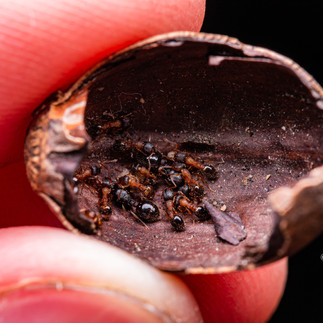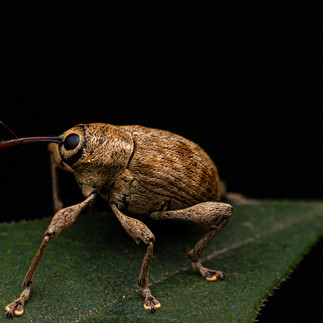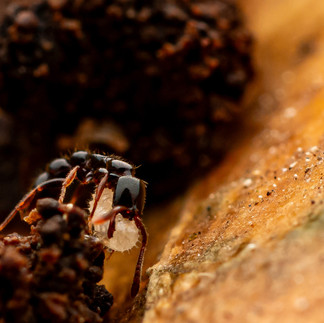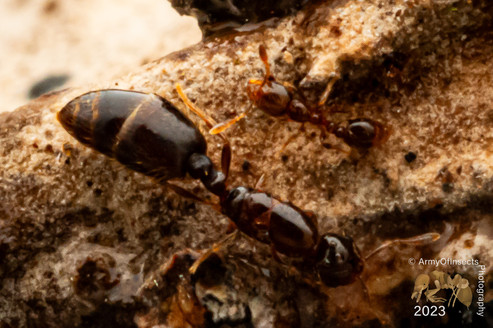On Nucicolous (Nut-Dwelling) Ants
- Josiah Kilburn
- Sep 20, 2023
- 14 min read
Updated: Sep 22, 2023
During Ant Course in Papua New Guinea, I collected a few species of ants from inside nuts. In this short post, I investigate that behavior and share pictures of various nut dwellers.

Myopias cf. tenuis colony nesting inside a nut.
Why Dwell in a Nut?
You may have heard of 'Acorn ants' or Temnothorax if you're from the eastern US or Europe. Despite the common name, not all of these ants live in acorns, especially in the western US and other parts of their large range, where Temnothorax nest under rocks and bark (1). But the behavior for which Acorn ants get their common name is the one that I wish to highlight in this article, despite it not being the most common biology across the genus. That is, I wanted to highlight Temnothorax 'acorn ants' because they do nest in nuts.

Temnothorax cf. cokendolpheri from under a rock in Larkspur, Colorado, USA

An 'acorn ant' Temnothorax curvispinosus foraging on summer foliage in the Great Smoky Mountains National Park, Tennesee, USA
I also use Temnothorax (or 'Temnos' as ant keepers will often refer to them) for an illustrative reason. Temnothorax is a commonly occurring, more contemporary example of the behavior I want to discuss from Papua New Guinea: cavity-dwelling or nucicolous (njuːˈsɪkələs) ants. The latter term is apparently coined here, using the Latin Roots for "nut" (nux), and "living or growing in" (colere) can be approximated to the English 'Nut-Dwelling.' The term was coined in a joint effort between my roommate Benjamin Meyer (a Latin aficionado) and myself as an attempt to separate the behavior of nut dwelling from Cavity dwelling, because of my original confusion around that term. Among ants, it is equivalent to cavity dwelling as used by Booher et al. (2017) but is (in part) more fun to pronounce. It is also particularly useful when referring to various specialist beetles and moths that develop in nuts. The term nucicolous herein refers to organisms that specifically live inside a nut. Temnothorax curvispinosus and Temnothorax longispinosus are nucicolous species that rely on pre-made cavities such as nuts that have been created by other insects such as acorn weevils or acorn moths (which are also nucicolous). Other ants, such as Strumigenys rostrata, Solenopsis 'carolinensis,' Nylenderia sp. (there are at least 2 in KY), and the ones discussed later in this article can all be nucicolous.
Some nucicolous insects. Notice that they aren't always inside of nuts. Adult nucicolous insects may be found wandering or flying around like other foraging insects, as this allows for better dispersal of genetic material. what makes them nucicolous is the fact that they live in nuts for some portion of their lives.
Nut Dwellers of Papua New Guinea
The first observation of Myopias dwelling inside a nut...
Let me paint the scene for you:
We had just ascended the second hill during our first day of fieldwork. A hill that, upon descent, would result in me 'eating mud' more than once. The ground was littered with strange pink and blue fruits, and the sky was barely visible from the onslaught of broad-leafed foliage above us. Other than the muddy path, the entire forest was covered either in a layer of leaf litter or fallen (rotting) logs, which produced a smell that can poorly be described as 'rich and earthy.' The air was of course thick with humidity, and so each breath felt full, and at the same time 'empty' (2). I had fallen towards the back of the group and was starting to get 'antsy' (my knees were bothering me and I wanted to stop to look for ants).
Fortunately for me, a large group of about half the participants had stopped just beyond the crest of this hill, among them were Brian Fisher, Mattias Menchetti, Phil Hoenle, Nils Schaumer, and François Brassard (I also think that Christina Blebea, Arthur Matte, Erica Lampers, Matt Hammer, Joshua Spitz, and Bree Clouten were in this group, but if you held me at knifepoint and asked me to recite the group correctly, I would be much less certain on these individuals and I would certainly perish. I am not sure what would lead to that scenario but I have now imagined the outcome I guess). As we settled down to collect, Brian and several others found a tree and dug around it looking for subterranean ants.
At the time, I was frustratingly trying to figure out how to use the note-taking system they taught for the course. I had some vials of Enctomomyrmex, Carebara, and Pheidole which had not been labeled. When I attempted to get my set of labels out, I discovered that the sweat in my shirt had caused all the labels (which were connected via a small strip of the paper) to 'disassociate' and fall into about 25 chunks of varying length. When I tried to find the JKPG 11 label (or whatever I was on), I did not succeed and instead dropped about 35 different labels on the ground which I had to pick up. It was at this point that I just gave up and started assigning random labels between 11 and 115 to everything and then recording it in the order in which It was collected. I only used up to around 85 at the highest, and the next day I elected to bring a plastic bag to prevent this error, I fact effective at keeping the labels together and dry. (Now I use pre-cut labels and label them in the field per the suggestion of Doug Booher).
Following the label frustration (or in the middle of it, I cannot quite place it properly), I had also just gone through the frustrating scenario of trying to photograph Lordomyrma that were perusing around (and nesting in) a termite mound as 2 people repetitively pooted (3) the workers before I could get a reasonable photograph of them in vivo. Deflated by this experience, I returned to my bag to put vials away and took a picture of a spider that was next to a Pheidole nest.

The less than satisfactory, out-of-focus photo of Lordomyrma perusing its termite mound nest.
It was at this time that someone, I cannot remember who (although it was presumably someone in the knife point group), pointed out an Aenictus raid. Aenictus are small old-world army ants that are essentially American Neivamyrmex (but not really, because they're separated by an ocean or two). They raid other ant colonies and steal their brood, at which they're incredibly efficient. Aenictus, being army ants, also have incredibly massive colonies (1,000,000+ workers) and are almost blind (4). All of these traits lead most ants to avoid them at all costs, even going as far as to abandon their nests or build special structures to avoid them...
So one could anticipate my surprise when I randomly found a nut in the middle of an Aenictus raid path that, when opened, contained a colony of small black ants. At first, I thought them to be Dorylinae (in part because I remembered reading that Doryline ants tend to leave each other alone) as they looked quite strange to me. Only after photographing them did I find out that they were in fact Myopias tenuis. They also seem to be the first colony of Myopias collected from inside a nut.

The nucicolous colony in question: Myopias cf. tenuis inside a nut.
What is more interesting perhaps, is that it appears to be one of the first detailed records of a Ponerine ant to observe this behavior of nesting inside nuts. The Booher et al. (2017) study found a few records of Ponera Hypoponera and Brachyponera chinensis within nuts in the Southeastern US. [I am uncertain if this means there were multiple functional colonies in the nuts or just satellite nests, but I would assume the smaller ponerines could nest inside a nut.] This observation of nucicoly may be one of the first of its kind, being a report of a tropical species, Myopias tenuis dwelling within a nut. My sample size is limited by my experience. This is certainly the first such record of ants dwelling within a nut that was in the raiding path of an army ant.

Hypoponera queen that landed on a moist log in Baitabag Papua New Guinea. Hypoponera has been reported nesting inside nuts.
The colony contained approximately 50 workers, one functional gyne, and 3 alates. They were mostly concentrated between a fairly flat layer between the shell of the nut, and the soil-like insides of the nut (possibly created by another nucicolous insect, maybe a moth). The ants had carved (or widened) a nest hole in the nut that was about 3x the diameter of the worker. They had millipede refuse in their nest, indicating that this colony had been eating millipedes. In the first (one of very few) picture of the alates I saw, I mistook the alate for a Parvaponera queen. I have not yet had a chance to actually confirm this with the specimens, but I think it was just a cowl of a Myopias queen.

Here you can see the confusing photo of the Myopias alate, with bonus evidence of millipede predation.
Gallery of images depicting this colony of Myopias cf. tenuis. Click on an image to enlarge.
This observation accidentally provides an insight into an [unexplored?] army ant avoidance behavior. I don't know how much research has been done on this account, but it seems that nucicoly may be an effective protection against army ants for small colonies of ants. I would not be surprised if this simple fact contributed to overall nucicolous ant diversity in the tropics by giving nucicoles a behavioral advantage to avoid army ants.
The Solenopsis colony that was completely contained within a nut.
Compared to the exciting narrative about climbing a difficult hill and a poorly placed analogy about violent crime, the story of this Colony may be less interesting. But, being my favorite genus of ants, this observation of nucicolous Solenopsis maxillosa is also my favorite Ant Course observation discussed in this article. I would rather you not picture this scene, but I would like to provide context to explain how I was in a position to make this observation:
It was our 4th field day, and our second at the Mano site. The site was much more rugged than our other site and required 4-7 river crossings (you lose track after your shoes get soaked) just to start climbing the hill toward the ridge where many other participants got the exciting experience of seeing Mystrium (a rare Amblyoponine Dracula ant). I never actually ascended the ridge, in part due to me being lazy, in part because I was worried about my knees, but mostly because on the second field day in Mano, my digestive system disagreed with me... Vehemently. For this reason, I decided it was probably a good idea to sit in one place and dig for ants as I allowed my bowels to settle (fortunately I had no issues for the rest of the day).
So I decided that a large tree where Mattia Menchetti found a possible colony of the 'teddy bear' Pheidole was a good place to start digging around. At the base of the tree, I actually found very little, unfortunately. I dug about 4 feet into the tree base, and had little to no luck finding anything. At some point, I did find some Prionopelta (a tiny little Dracula ant that I had never seen before), Some Rhytidoponera (often called 'pony ants'), and some Odontomachus (a fairly popularized genus of trap-jaw ants). At that point, I decided to take a break and try to set out a bait. I didn't have any pecan sandies (the ideal cookie for baiting ants), so I just used some incredibly melted trail mix that I ate the rest of. Unfortunately, my baits did not attract the Pheidole I was looking for, in part because I knocked most of them over later.
After I set the baits, I took a short break and sifted some leaf litter in a Davis sifter. There were a few interesting finding from this, I am pretty sure I collected more Prionopelta and later Crematogaster. Ultimately though, I did not find too much in terms of PNG ant diversity at my one tree, but it is still much more than I would find at one tree in Kentucky. To make matters more unfortunate, my camera was not charged, which was incredibly frustrating, because I saw a Rhytidoponera worker subdue and kill an Aphaenogaster (Doleromyrma) worker who was posed perfectly for a spectacular photograph. In fact, I didn't want to forget what position they were in so I actually sketched them out earlier (partially inspired by Elaine's recent work from Ant Course Vietnam) as to hopefully remember it later and illustrate them for an entomology club activity.
But this sedimentary situation is what gave way to my next discovery of a nucicolous ant colony. In fact, it gave way to two separate colonies of two species of ants within their own nuts. One of them (Monomorium sp.) was not photographed because the nut fell apart in its test tube. But I did happen to find a Solenopsis species within a nut in PNG, and that was (the essentially unknown) Solenopsis maxilla.

Solenopsis maxilla inside their nest nut.
Solenopsis maxillosa were described by Emery in 1900, in a paper about ants of New Guinea. The paper was in Latin, and thus determining the species descriptions took a little bit of work. Fortunately both types from the paper are available on Antweb. One thing I noticed about the workers which I primarily used to distinguish them in person was that the Pronotum of S. maxilosa has prominent angles, and the specimens of S. papuana lack them in every case. Beyond a description of the queen and worker, no information is provided on this species.
I collected this species in a nut and their colony had 3 (or 4) queens. The colony was nesting throughout a nut with a 2cm diameter. The nut was highly rotten and found underneath ~6cm of leaf litter. Brood was evenly distributed about chambers and appeared to be piled against the floor and walls of chambers. This is different than the lignicolous Solenopsis sp. I encountered in Tennessee (5), that stick brood to the sides, floor, and roof of chambers in their log nest. Diet is unknown, presumably, they are generalists (I say this because their nest was contained entirely in the nut), but they were nesting next to Monomorium (6).
A gallery of other Solenopsis photos, unfortunately most of which have unsightly white LED dots from a focus light. Two of the queens had a damaged gaster, this is a result of trying to remove them from the nut.
Those other Solenopsis that were possibly nucicolous
In addition to S. maxillosa, I also found S. papuana which bears the name of the region. Apparently though, these are sort of a 'trash bin' species that have made their way around the Pacific and are probably a messy complex of interrelated species. The small collection of workers I made was from between wood fiber layers of a coconut.

Solenopsis papuana in its coconut, note the fungus gnat larva nearby.

Solenopsis papuana portrait on white background.
Other PNG Nut Dwelling Ants:
Intrigued by these nucicolous ant species, I later opened 22 nuts at Baitabag. They were very close to the canopy crane and trail (17m away). All but 2 had some lignicolous organism, and 9 of them had lignicolous ants. Among the lignicolous ants were
Hypoponera sp.
Wasmannia acropunctata
Pheidole sp.
Monomorium sp.

The invasive Wasmannia acropunctata, which can make pets and livestock go blind
The discovery of Wasmannia acropunctata in nuts was mildly disappointing but was to be expected. They are quite prevalent invaders across the country. There were no complete nests of Wasmannia inside these nuts, instead just satellite nests. The nests of Hypoponera sp. and Pheidole sp. both had queens. Unfortunately, I think I only collected the Pheidole. The Hypoponera was an accidental first find that made me open more nuts.
Nucicolous colonies of Pheidole, Monomorium, Hypoponera, and Wasmannia are not pictured. These were not photographed alive or not collected in some cases.
A Nut Dwelling Beetle
In a few of the 22 nuts I opened, there were collections of this wood borer beetle which inhabited nuts and lived in small families. I know nothing about the beetles except that there may be 2 species pictured and that they lived towards the edge of the shell.

This borer beetle looks to be the same as the pupa pictured in the bottom left corner

Below is another shot showing the borer beetle pupa and another beetle.

The photograph that makes me ponder if there is in fact two species of beetle pictured. One is significantly smaller than the other.

Kentucky Nut Dwelling Ants
When I returned to campus, I was teaching about nucicoly and I wanted to find some nucicolous organisms for my Entomology club. I opened 47 nuts, either acorn or Hickory. Across these, I found 9 Colonies of Temnothorax curvispinosus and 2 Colonies of Nylanderia sp. Most nuts were empty, but just under half of them had a moth or weevil larva.
The Need for a Term Nucicolous
I have been thinking about the usage of the term Nucicolous since I started writing this article. I find it useful, if not entirely for ants. I think that, as is detailed very clearly by Doug and his Colleagues (A), the ants that nest inside nuts can often be found in other cavities like spaces beneath the bark, pockets in rock, and holes that have been premade in wood. But I think there are two reasons why this term is important and useful.
Leaf Litter Diversity and Nucicoly
To a lesser extent, this term is needed because it helps resolve a conceptual error when trying to understand insect leaf litter diversity. Nucicolous insects are a part of overall leaf litter diversity because their nuts do help comprise the litter layer, but based on our usual leaf litter sampling methods, they are not as well accounted for. This is because they require a different collection technique (or at the very least, a modification of sifting that includes chopping nuts in half) than litter sifting to adequately collect them. After collecting quite a few nucicolous ants during Ant Course Papua New Guinea, I realized that there seems to be less effort to study nucicoly in the tropics. As far as I could tell, the extent of Nuciolous research in myrmecology is quite restricted to Temnothorax and a small number of other papers including the Booher et al. study and a study on the ants of Chinese rubber plantations. The diversity of tropical Nucicolous ants is widely unexplored. A brief study of tropical nuts and their ant assemblages might be interesting, especially if compared to general litter sifting. You would probably want to identify the nuts and measure the dimensions of the outside and inside of the nuts, as well as report the cases where nuts are filled with debris or chambers (as was the case with Solenopsis and Monomorium). Another thing to keep track of might be the number of nuts that had beetles in them, and the general rot level of the nut (a scale would need developed).
Insect Biology and Pest Management
Reflecting on the presence of nut-boring weevils, like the acorn weevil or the Galip nut weevil, led me to this realization: We should have a term that helps us distinguish the stages of the organism that actually inhabit nuts, versus the ones where insects spread to other nuts and mate. For example, only the larval stage of Curculio glandium is nucicolous, but mostly all life stages of the mystery PNG borers are nucicolous, although there is likely a time when colonies are forced to move to different nuts, this term would need a different name possibly, Nuciclinous, but the jury is out on that one because it is basically identical in form to nucicolous.
References/Footnotes/Definitions
References
This publication is referenced several times in this article. I would recommend it for those wishing to learn more about nucicolous ants and particularly those in the Southeastern United States.
Footnotes
(1) It seems that most Temnothorax are not acorn ants sensu stricto (meaning in the strict sense, as I recently learned), especially in the western US. One interesting observation I have made about this genus is that I am in fact allergic to their venom. I have been stung by 3 species: Temnothorax rugatulus, Temnothorax andrei, and Temnothorax sp. 'Lake Tahoe'. The latter of which, which I collected in Lake Tahoe, originally was mistaken to be a Leptothorax calderoni colony, but it had a macro gyne, so it was actually Temnothorax. The source of the confusion was due to the fact that the workers looked eerily similar to L. calderoni and they were collected within a mile of the type locality .

Temnothorax sp. 'Lake Tahoe'
(2) I have no great way to describe the feeling of breathing in very humid air. I grew up where there was usually close to 0% ambient humidity, and something about breathing humid air deserves note. The breaths feel more full or rich, but if you take a full breath, it almost feels like you are missing something.
(3) The verb pooted, refers to the noun pooter. Both of these are quite delightful terms despite applying to rather scientific terminology. A Pooter is a device used to suck in ants that is similar to an aspirator, but unlike the aspirator, the pooter is designed (mostly) for collecting ants mostly into ethanol or small vials. Instead of having 2 tubes connected to a chamber with a filter (+ optional but recommended fuel filter), the pooter is comprised of one sturdy tube nested with a filtering piece of silk screen inside another, larger more flexible tube (+ inline fuel filter).
(4) The book Army Ants by Daniel Kronauer is one of the best ant books I have ever read. It's incredibly well written and wonderfully illustrated with many awesome photos of army ants of all varieties. For more in depth information about Aenictus, Dorylus, Neivamyrmex, or any other army ant I suggest that one turn to this book for all your 'army ant needs.'
(5) Unidentified lignicolous Solenopsis.
(6) Solenopsis 'carolinensis' will emerge from Monomorium miniumum nests in late July for nuptial flights. Thus showing possibility for Monomorium as a host for cleptobiosis.
Defininitions & Conjugations
I wanted to include this section to encourage people to use these words.
Nucicolous
/ njuːˈsɪkələs /
adjective
(of animals) living inside a nut or nuciform cavity.
Derived forms
Nucicole, noun, to describe a nucicolous organsim
Nucicoly, noun, to describe the behavior as a whole
Etymology:
From the Latin nucis for nut + colere (to live in or on)
Poot
/ Po͞ot /
verb
To collect insects (particularly ants) with a specially designed aspirator called a Pooter
Derived Forms
Pooted, verb, past tense of poot
Pooter, noun, specialized aspirator used to collect ants (see footnote)
Etymology
Onomatopoeia, the sound of aspirating ants with a Pooter.




































































Comments